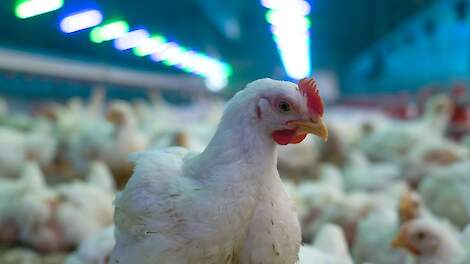Gumboro disease usually shows a decrease in feed intake, drowsiness and watery to slimy stools in the early stages of the disease. Depending on the type of Gumboro virus, the type of poultry and the flock’s protection against Gumboro, the loss can quickly increase. Especially with rearing laying hens, we see that in an unvaccinated flock the mortality can sometimes be more than 50%. But slow-growing broilers are also very sensitive to this.
After the virus infection, there is an increase in dropout for 3 days, which then gradually decreases. Broilers may be dissected with an abnormal Bursa, as well as bleeding in muscles and organs. Secondarily, the kidneys are affected, causing diarrhea and associated fluid loss. In addition, the Gumboro virus suppresses the immune system, making a couple more susceptible to all kinds of other infections. The result is reduced growth and development, but also more failure at a later stage or more rejection. These observations fit into a picture of immune suppression, a condition that does not show any clear clinical symptoms but does cause the immune system of the chickens to be suppressed. This suppression gives other pathogens more chance to manifest. In couples with less resistance, we see more cases of coccidiosis, intestinal disorders and E. coli. Marek’s disease, REO infections, intoxications and certainly also infections with Gumboro virus have been described as the cause of this.
Gumboro UK 2019 variant
It has already been described that a new variant of Gumboro was found in Dutch poultry, called UK2019 or 98.1% DV86 (GD), two names for the same virus variant. To see what the status of vaccination and variant virus circulation is, HIPRA conducted a study in Dutch broiler farming. At 66 farms, 77 FTA card samples were collected from flocks at least 14 days after vaccination. These were sent to the HIPRA laboratory in Spain to detect and characterize the Gumboro virus or not.
If a flock has been vaccinated with a drinking water vaccine against Gumboro, you expect to find the vaccine virus at least 14 days after vaccination. A negative result means that a live vaccine was administered too early or inaccurately. However, it is also possible that other variants are detected that could have infected the animal before the vaccination had an effect.
In only 50% of the flocks sampled, the virus used for vaccination was detected, 9% no virus and in 14% of the flocks a different vaccine virus than the one used for vaccination. It was striking that the percentage of 27% of the flocks in which the new variant was found were usually vaccinated with a mild vaccine or with a recombinant vaccine. Vaccination with an intermediate plus vaccine usually resulted in good protection.
Contemporary outbreaks with a new Gumboro variant, the UK2019 (GD: 98.1% DV86), usually only show symptoms of reduced resistance, but can ultimately lead to disappointing final results. It is therefore advisable to contact your veterinarian if the flocking results are disappointing and to conduct further investigation into Gumboro disease.
If you would like to know more about the Gumboro virus or have questions about preventive protection at your company, please feel free to contact the HIPRA poultry veterinarians: Pieter Kuhne +31 6 8289 6434 or Patrick de Jong +31 6 2610 5061
2023-05-25 13:25:24
#HIPRA #Recognize #Gumboro #Disease #Pluimveeweb.nl #News #poultry #farmers

